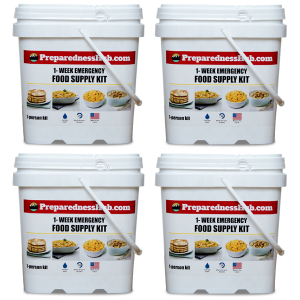 OK, that was crazy. What you prepared for and worried about all these months actually did happen. You had to grab your family, snag your “bugout bag”, and make a run for it. A close call, but everyone is safe from the fire/flood/earthquake/hurricane/riot/tornado/whatever.
OK, that was crazy. What you prepared for and worried about all these months actually did happen. You had to grab your family, snag your “bugout bag”, and make a run for it. A close call, but everyone is safe from the fire/flood/earthquake/hurricane/riot/tornado/whatever.
Now your evacuated, you have found a sheltered spot where your family can take a deep breath and wait for the first responders and circumstances to allow you back into your home. You rig a tarp, everyone is in warm clothes, and of course, the youngest one turns to you and says “I’m hungry, when do we eat?” Granola Bars keep the need to fix a meal at bay for an hour or two, but those are not going to hold everyone over for days.
Of course, being prepared as you are, you have sufficient rations of actual food in your bag. You take inventory, plenty of dehydrated meals to last several days. Check. Water to prepare them as well as enough to drink or a reliable source nearby and a method to purify it? Check. But all the instructions call for boiling water for several minutes. Have you prepared a way to cook what will keep your family from going hungry? Here are your options:
 
Survival Cooking Tips
Good old wood. If you live in a forested area, with plenty of dead and down wood (living wood won’t burn well), this is a great option. No fuel to store, just gather and burn. Two things to consider: In a chaotic situation, will it be safe for you and your family to be roaming around gathering firewood, and in some rainy or snowy circumstances, finding dry wood might be a challenge. You might also consider a lightweight wood stove to concentrate the heat. SurvivalBased.com sells the Sierra Zzip stove that burns wood, or just about anything else organic, but uses a fan under the flame to turn a flickering flame into a blowtorch perfect for heating a meal.
Packaged fuel stove such as heat tabs or alcohol. A lot of prepackaged kits that include stoves use this solution, including us! Our 72 hour kit with stove is here. We also have a freestanding stove that uses heat tabs. Advantages: Lightweight and mess free. No liquid fuel to store. Drawbacks: Less heat output, so getting water to boil takes a few minutes longer. You can also make or buy a simple stove that burns denatured alcohol. Except for the need to keep a fuel bottle around and filled, it’s also a lightweight option, but one thing to remember is that an alcohol flame is colorless-make sure it’s out before handling the stove after dinner.
 
Survival Cooking Stoves
Canister fuel stoves. What’s not to like? You just turn on the gas, light, and you are in business. For survival purposes, a lightweight unit that burns isobutane canisters available in any sporting goods store is perfect. Two or three medium canisters should cook all the meals in a 72 hour kit. You can buy them alone, like this unit, or in a system, paired with a pot like the Jetboil. The advantage to a system is that it wastes less heat, so water boils fast, fast, fast. The one drawback is that pretty much all you can do is boil water. Frying pancakes or eggs, or anything that is not just placed in a pot and boiled up won’t work. Perhaps more of a consideration when using the stove for camping and recreation than in true survival mode. Also worth remembering: In extreme cold, like below 15 degrees Fahrenheit, canister fuel flows less freely. If it gets too cold, they won’t work at all.
White Gas. If your grandpa ever fried up bacon and eggs for you on a camping trip, he almost certainly used a white gas stove. They are still out there, and compact ones are available and widely used by serious outdoors folk. Over the long haul, white gas is less expensive than canisters, and one bottle of fuel will cook at least as long in my experience as three medium canisters. Also, cold weather doesn’t faze these stoves a bit. It’s what you would use to cook your noodles in the Himalayas. Just watch out for the Yeti! There is a bit of a learning curve to lighting these stoves-you have to learn how to prime it, light the liquid, then open up the stove after it has warmed up but before the flame goes out. And white gas does go stale, it’s a good idea to change what’s in the fuel bottle every year at least, unless you are using it on camping trips or otherwise.
So several good options, each with pros and cons. We here at SurvivalBased would love to hear what you plan to use for cooking in case of an emergency. Just log in below and tell us your setup. Happy prepping!


 1-Week Food Supply Kit (4-Pack)
1-Week Food Supply Kit (4-Pack)
1 comments
I plan on making one of those tin can rocket stoves for emergency use. I live in a great area re: available small twigs, and tree branches. So here is my question. If I gather the the dry wood and store it in a covered plastic barrel in an outside shed. Would moth balls in the barrel (to repel insects. Carpenter ants are prevalent in our area) cause toxic fumes when burning the wood?
Any info would be helpful, thanks.
Patt D
SW MI